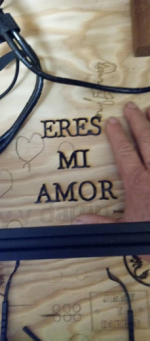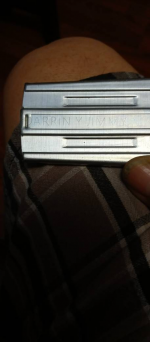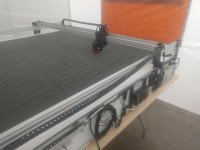Hey keep-it-real,
A key thing to understand about how laser cutting works is that it's not quite a knife (even though commercial laser cutters make it look that way!), it's the use of light to get part of the material so hot that it burns, melts or vaporizes. So when you're thinking about cutting something with a laser, you're really thinking about what very concentrated high temperatures will do to the material. The reason CO2 lasers are versatile is their high power and ability to focus well - by delivering a huge amount of energy to a tiny point, almost any material is going to vaporize very quickly, resulting in a clean cut (but even then there are some off-limits materials, because some things produce extremely toxic gasses when they burn, which remember is fundamentally what the laser is doing). Since you already know the specs of the laser you have and know how it performs for you, I guess the short answer is it depends if the current laser you have is 7W optically or electrically. If it's 7W optically, you're not going to do much better, that's as powerful as diode lasers come at the moment. If it's 7W electrically, yes there are more powerful laser modules around that might give you better results, but even they aren't quite perfect. Here's a few points that might help steer you as you keep looking into this stuff.
*Quick note - Since you have experience with lasers and laser cutting, I'm guessing you know a lot of this stuff already, and I'm not insinuating that you don't! I'm just going to run through all the fundamental points because that's easier than trying to guess exactly what your level of experience/background knowledge is and how much research you've done already. If there are one or two things in here that help you out or give you some new information, great! The rest can be a resource for less experienced people who come across this thread. If you're at the point where you're looking for more technical information or have questions specific enough that nothing in here is particularly helpful, please feel free to ask them or send them my way, and I'll do what I can to give answers/explanations better tailored for you.
Power:
Even though diode lasers can be extremely powerful, even the best single diode laser is an order of magnitude less powerful than even a mid-tier CO2 tube. For that reason, most diode-based laser CNC devices are best thought of as laser engravers, rather than laser cutters. If you set them to move slow enough, they certainly can cut through thin materials, but in so doing, they tend to do a lot more damage to the surrounding area and give you a less clean cut. Imagine a 80W CO2 laser as a red hot wire cutting through plastic - it's going to make a fairly clean cut because it melts through so fast the rest of the plastic doesn't have time to get hot. In this respect, a diode laser is more like a knife you're warming with a lighter. Sure it will work, but getting the part of the material you want to melt hot enough will take so long that a lot of material around it is going to start to char and melt too.
Wavelength:
Different wavelengths have different advantages and disadvantages when it comes to laser cutting. Depending on how much experience you have with lasers (or just with light in general) you know that when it comes to the lasers most people use as a hobby, "darker colored" things tend to burn more effectively. Again, this might be totally obvious to you, and if so sorry, but I think it bears repeating so that you keep it in mind for your application. The reason this happens is because materials that look "dark" in color to us absorb a relatively large percentage of the visible light that hits them across a wide portion of the visible spectrum. If it looks dark to your eyes, that's precisely because it absorbs visible wavelengths well, indicating that visible wavelength lasers will also be well absorbed. This isn't set in stone though, as different colors can be produced by different mechanisms. CO2 lasers are different for a few reasons. First, they're infrared, meaning that how a material looks visually doesn't tell us anything about how the light will interact with it, because we can't see the infrared light either being absorbed or reflected by it. One of the advantages to the high power of a CO2 laser is that even if the wavelength is absorbed poorly, there's so much excess power to go around that it still might work decently. Because diode lasers are comparatively less powerful, wavelength selection matters a lot more, and not every diode is going to work well for every material.
Beam:
Laser engraving and cutting applications need a very well focused beam. I know you mentioned that you aren't trying to do extremely fine detail work, but that isn't really why focus matters. It's all about the density of the delivered power. A less focused beam won't just cut a thicker line, it will take much much longer to cut through the material, if it does it at all. If you have your heart set on a diode, you'll ideally want something called single-mode, particularly one called TEM00. Basically this is a beam that looks how you'd imagine a laser looks - brightest at the center and dropping off in a uniform circle outward. These beams can be focused tightly and so are ideal for delivering maximum power to a small area. Other beam modes have odd energy delivery shapes, where they look more like bullseyes or even flower petals rather than a single spot, meaning even with the best focus, the energy isn't going to be as concentrated. And bear in mind, you can't reliably tell the mode of the laser by how its spot looks to you (with goggles on of course!) - the optics can introduce abberation that looks like concentric rings, making it hard or impossible to tell. Unfortunately, a lot of the highest power laser diodes are known as multimode, meaning you're not getting that single fundamental mode that can be focused ideally.
Mechanical:
You mention that one of the reasons you don't like CO2 lasers is that the mirrors seem fiddly, and thats absolutely true. Getting the mirrors aligned is difficult and is inherently a trial and error process, and if the mirrors get dirty, they're going to start absorbing the laser light, both reducing your cutting power and causing thermal damage to the mirrors themselves. Even though this is a weakness, it's actually an advantage over diodes - right above the cutting zone is a dirty place. Smoke, ablated particles, etc. A mirror can be cleaned or even replaced, but if that smoke and debris damages the laser optics, you could potentially have a much bigger/more expensive repair on your hands, if you can do it at all. That's why a lot of CO2 laser cutters have an attachment right near the cutting head that blows pressurized air directly at the point that the laser is burning. This not only clears away smoke that can absorb light and reduce cutting power, it also keeps the smoke and debris away from the sensitive optics.
Safety:
I'm going to spare you the introductory version of the safety talk because it looks like you have experience, but there are some specific safety things going on here that you need to think about. Obviously, you need high quality laser goggles any time you're using a powerful laser. Your retinas are far far easier to engrave than any material, and infinitely less replaceable. As for specific safety matters with this application, it's easy to think that this setup is marginally safer because the laser is fixed pointing down at the work surface, but that's not the case. When materials burn and melt they can become much more reflective than they are normally, and the irregular shape means that reflected light is going everywhere. Not to mention, if you did end up going with a mirror based design, you need to be extra careful. If you bump one of those mirrors, not only are you going to throw off the calibration of your system, you're going to get a full power beam shooting off in an unexpected direction. Wherever you use this needs to be a controlled area where you know that no one is going to be around the laser when it's running. Even then, I'd highly recommend building an enclosure for the laser, this is both good for blocking stray light from getting out, and containing the large amount of smoke any laser cutting setup generates so it can be sucked away by a ventilation system you'll also have to build.
One last note, you mentioned those laser modules being listed as "15W" or something along those lines - that is not 15W of optical power. That marketing practice isn't quite as deceptive as those obviously bogus ads for like "30W BURNING LASER POINTER BUY NOW!", but what they're doing is stating the electrical power consumption of the module, which includes all the losses introduced by the driver circuit. As far as I'm aware, the most optical power you're going to get out of a diode based module is about 7.5 watts in most cases.
I know that was a doozy of a post, sorry for the reading assignment. Basically, I wouldn't give up on CO2 lasers just yet if you have your heart set on cutting things. Until there are some big advancements in the power capabilities of diode lasers, CO2 is just better for cutting in most cases. I know diode lasers have a big price advantage, but there are inexpensive CO2 lasers out there, and rather than building one from scratch, you can look into buying one of the inexpensive ones and modifying it to be more capable and suit your needs. Diode lasers can be great though, just not ideal for cutting patterns out of fabric, as you've experienced. I'd be thinking of using a diode laser to engrave things, like you could burn really cool designs onto leather (REAL LEATHER please, fake leather is often made of PVC, which produces lethally toxic furans and dioxins when it burns).
I hope I was able to answer some of your questions and give some advice, if you want to know more/have questions about any of the stuff I mentioned, please don't hesitate to ask!
Cheers,
LM







